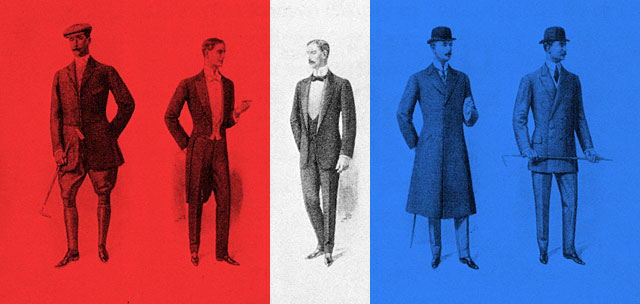Commercial brands are increasingly engaging with social movements in order to better ground and express their core values. This is certainly nothing new. Here in the United States, since as early as the 1920s, major commercial brands have been intentionally aligning with social and cultural trends on a national scale in order to create customer advocates. Working out the ethical implications of this sort of approach can be tricky; they have to be considered carefully on a case-by-case basis. We know that brands capable of recognizing and aligning with social trends can attract attention through – and reciprocally reinforce awareness of – the causes they espouse. But this raises the question of distinguishing positive social trends from negative ones.
At Culture we recognize that memory is central to the exercise of foresight. While no professional can claim to be skilled in the arts of prophecy, the analysis of trends against a historical background, and the making of reasonable guesses about where they’re likely to take us are both possible and prudent. The following short article considers brand associations with ‘gentlemanly behavior’ that Jack Daniel’s is currently doing a great job of strengthening. But in keeping with the aforementioned advice about remembering historical context we’ll first take a look at a similar and earlier example – in this case the association of a whole category of brands with the movement to challenge women’s traditional societal roles.
In 1928 Edward Bernays published a small book entitled Propaganda. In the years that followed it has come to be considered a classic text on social manipulation. In addition to being an author interested in discussing how to present ideas to the public in compelling ways, Bernays was also the nephew of the now famous Viennese mentat Sigmund Freud. Like his uncle, Bernays was an extremely perceptive individual. He not only promoted his uncle’s psychological ideas, he also put them into practice in his commercial communications work, establishing a role he dubbed “Counsel on Public Relations”. When he chose the title of his little book the term “propaganda” had only begun to be associated with Machiavellian efforts to influence public opinion. Oddly enough, while “propaganda” has come to have very negative connotations, the term “public relations” has survived and gained great currency.
In the course of a little-known but nonetheless spectacular career Bernays set something of a standard for successful PR work. One illustrative example was discussed in the informative and award-winning 2002 British television documentary The Century of The Self. It involves his work in the late 1920s for George Hill (at the time the President of The American Tobacco Corporation). Hill was concerned because women weren’t smoking. At that time it wasn’t socially acceptable. But Hill realized that if women could be encouraged to smoke he would effectively double his potential market.
Bernays was brought in to help crack the nut. On the recommendation of his Uncle Freud he consulted a psychoanalyst. At this time psychoanalysis was virtually unknown in the United States. The psychoanalyst in question, A. A. Brill, told him that cigarettes were a symbol of male power. After some consideration Bernays hypothesized that the key to market share currently locked up by taboo was to link the act of smoking cigarettes to the movement for women’s liberation, which was at the time very much in vogue. Bernays arranged for a public relations event. He instructed a group of wealthy society women participating in New York’s Easter Day Parade to conceal cigarettes in their clothing. At a predetermined time they brandished their cigarettes and proceeded to light them as symbolic “torches of freedom” – as Bernays himself described it in his communication with the press. Freedom to smoke was intentionally linked by Bernays to the idea of freedom from social restrictions seen as old fashioned and unfair. Bernays identified and worked with a cultural movement, thereby harnessing a powerful force.
Hacks repeat what flacks tell them to because they’re under deadlines and they need stimulating material. As a skillful PR man Bernays delivered exactly what most writers are looking for: something to talk about. To use his own expression, the technique was straightforward: “substitute purpose for chance”. Of course there’s also the (not so) small matter of how Bernays skillfully identified nascent cultural expressions early enough to work with them during their emergence, associating his client’s offering with deeply felt collective desires.
Today, the smoking of cigarettes – to say nothing of promoting them – is very much out of fashion. It’s therefore easy for us to dismiss what Bernays did as nothing more than crass and mercenary manipulation. But it’s important to remember that the negative effects of smoking on health were not well known in the 1920s. Judging the actions of others in the past based on today’s standards is always questionable; despite how we might feel about promoting smoking, Bernays arguably did help to bring about positive social change for women through his actions. There is a reciprocity involved in any attempt by a brand to resonate with a social movement. At the same time the brand exerts an influence on a movement, the movement exerts an influence on the brand. And once the link with a social or cultural movement has been established as profitable the continuing association of other products or offerings in the class with that movement is virtually guaranteed. After all, imitation is the default setting for advertising ‘inspiration’.
The standard themes of empowerment and of challenging male dominance that were established as effective advertising to women by Bernays were imitated in thousands of ads. The marginal figure of the flapper – known for rejection of traditional morals, sexual freedom, smoking, and drinking – moved into the mainstream as a fashion keystone. Even after the Wall Street Crash and the rise of the Great Depression that brought the Roaring Twenties to a close stars like Katherine Hepburn rose to prominence wearing trousers, while designers like Coco Chanel designed costumes for MGM stars. By 1968 Virginia Slims could proclaim “You’ve come a long way baby”, which reveals the continuing association of smoking with the themes established by Bernays. Freud’s nephew had correctly identified a cultural shift and intentionally worked with it, rather than against it. Time has proven the correctness of his early observations.
But these days we know smoking is not good for you, and like the movement for women’s liberation in its day, the movement for more responsible branding, marketing and advertising is today becoming a force to be reckoned with. If we accept that the technique of working with powerful social trends is effective, and that this can create a kind of cultural feedback mechanism whereby advertising reinforces and promotes these trends, we also have to recognize the power advertising and other brand communications have to shape our society. This is the point at which we have to ask ourselves what kind of world our work creates. How is it that we would like the world to be? Brands are increasingly being held accountable for the ways in which they affect individuals no less than society as a whole.
The strikingly effective manipulation of opinion involved in introducing cigarettes to women stands out today as morally questionable. But the same techniques remain in use, though in much of the commercial world they are usually developed and deployed as a result of flashes of individual insight rather than the systematic application of a body of knowledge. It’s even possible to imagine that the same basic approach taken by Bernays can be a source of less ambiguous positive change. Whether we tie smoking to suffrage or associate the physical cigarette in a woman’s hand with the torch in the fist of an established cultural memory image like the Statue of Liberty, the approach is undoubtedly effective.
If we bear the foregoing context in mind, it’s interesting to look at headlines that appeared in the news in July of 2012 regarding Jack Daniel’s. Louisville-based author Patrick Wensink’s satirical novel Broken Piano For President featured a cover that was obviously based on the Jack Daniel’s label. The lawyers for the Tennessee whiskey brand decided to send Wensink a cease and desist letter – but before doing so it seems likely that a perceptive PR or brand team had the chance to exert an influence on just how that was done. The result was a letter that Wensink himself decided to post on his website with this introduction: “What follows is, perhaps, the most polite cease and desist ever written. If it wasn’t signed by some lawyer, I’d imagine ol’ Gentleman Jack penning it himself, twirling his bushy mustache.”
As of the writing of this post (November 2012) a Google search for the terms “Jack Daniel’s” combined with “cease and desist letter” yields more than 40,000 hits. Most of them are news and blog articles that praise the actions of the company’s lawyers as “nice”, “polite”, or “gentlemanly”. Of course Jack Daniel’s is a whiskey brand. And the idea of gentlemanly behavior makes sense for a purveyor of spirits with Southern roots. Gentlemanly behavior also brings to mind ideals of maturity and refinement, which are key themes in whiskey advertising. But this appears to be about more than a single well-handled PR opportunity. Jack Daniel’s is increasingly emphasizing the importance of gentlemanly behavior. Their website currently features a banner, obviously timed for the election period, that reads “Jack Daniel’s supports all parties: Socialize Liberally, Drink Conservatively” and “Sometimes a piece of common ground is small enough to fit on a cocktail napkin.”
Here we see a strong brand that has made a commitment to a position that resonates with cultural values that we can’t help but find appealing. While there can be little doubt that part of the intent is to sell more whiskey, the goal is also clearly to express and promote mature values. The kind of fractious dispute we’ve all come to associate with legal proceedings and elections is answered by Jack Daniel’s with a call to gentlemanly behavior, itself tied historically and culturally to the sharing of a drink. An angry and argumentative attitude is not recognized as a cultural value, while gentlemanly behavior is. Whoever is behind the development of this integrated and coherent positioning work, they have shown a clear ability to recognize and work with the nascent social movement towards more civil behavior that gains momentum with each passing day.
Jack Daniel’s clearly understands the importance of cultivating brand value(s). In many ways we can’t help but agree with the position that the company is taking. At Culture we believe that between persons of good will, all differences are small. It seems that Jack Daniel’s has made a commitment to this idea as well. This is the kind of message that people are enthusiastic about getting behind. This is the kind of idea that people become advocates for. After all, we can all recognize that it amounts to a commitment to what we like to call Enlightened Self-interest.




